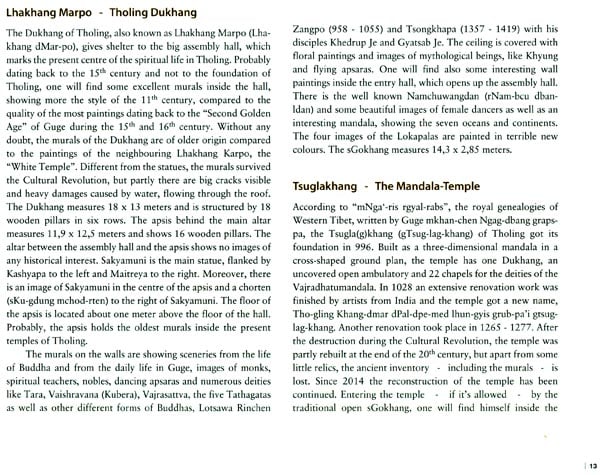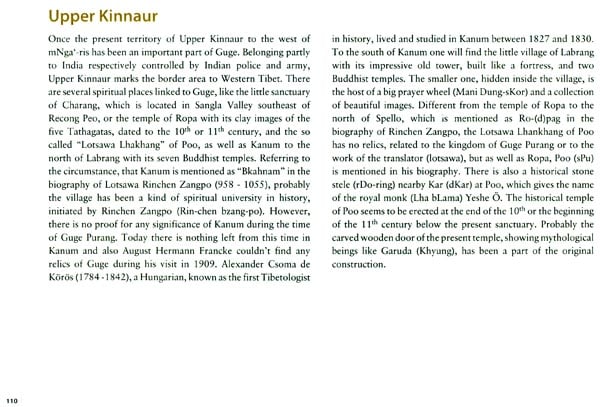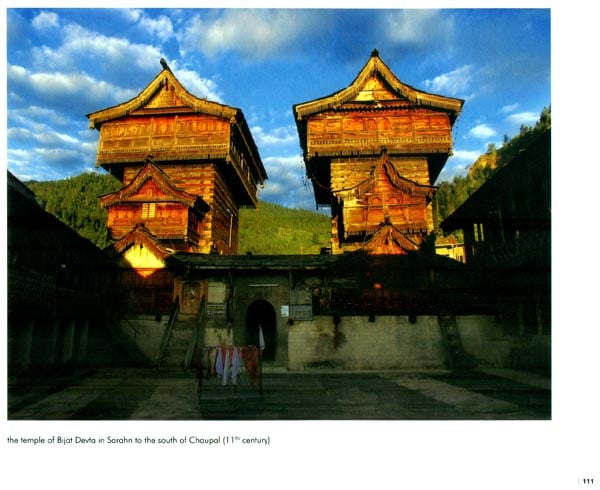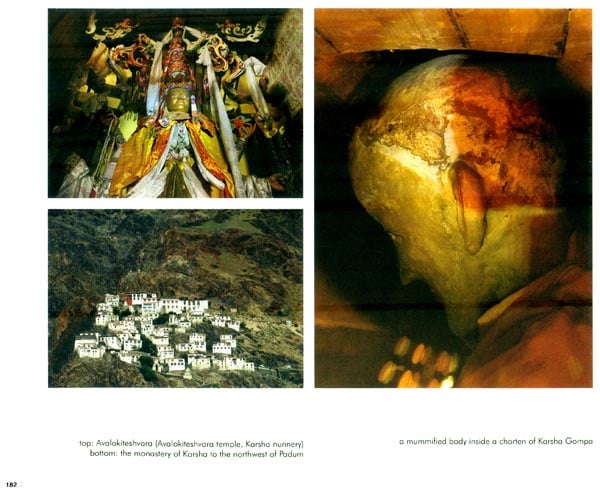
Tibet - Guge (The Cultural Relics of Ancient Western Tibet)
Book Specification
| Item Code: | NAO962 |
| Author: | Michael Beck |
| Publisher: | Vajra Books, Nepal |
| Language: | English |
| Edition: | 2018 |
| ISBN: | 9789937924566 |
| Pages: | 239 (Throughout Color Illustrations) |
| Cover: | Paperback |
| Other Details | 8.0 inch X 10.0 inch |
| Weight | 930 gm |
Book Description
Michael Beck, Born in 1966, is a German and Swiss architect as well as a photographer, living in Switzerland. Travelling many times through territories with Tibetan culture since 1997, he visited Tibet, Ladakh, Zanskar, Lahual, Spiti, Kinnaur and Mustang as well as other places, where Tibetan culture is visible in India, Nepal and China.
The kingdoms of Guge Purang, founded at the end of the 10th century, are one of the most fascinating mysteries, given by the Tibetan history. The outstanding spiritual art, partly visible till today in present Western Tibet, neighbouring Kinnaur, Spiti and Lahaul as well as in some spiritual cycles inside the monasteries of Ladakh, shows a unique work of fine art, done by artists, coming predominantly from India respectively Kashmir.
I don't remember the first time, I came in touch with Guge, but I remember very well the point, when I decided, to take a deeper look under the surface, by historical and cultural research. It has been in 2006, after reading a book, written by my friend Bruno Baumann, in which he described the rediscovery of Khyunglung, an amazing site of significant historical interest in Western Tibet, widely forgotten for a long time. Many years ago, my best friend Frank focused my view onto the arid mountainous landscape of Spiti, where the unique spiritual art of Guge survived partly untouched till today. A first try to enter Spiti in early spring 2003 found its end in the beautiful valleys of Lahaul, caused by the snow-covered Kunzum La, which made any access of Spiti impossible. A second try in 2006 was successful, different to the first scheduled research in Western Tibet in summer 2008, caused by the closing of Western Tibet after some turmoil in Tibet during spring of the same year. As well as in 2008, there was no possibility to enter Western Tibet in 2011 and 2012. It took time till 2015 to realize a second research in Western Tibet. Even if it was not possible to cover all the targets of this journey, the research was very successful. Together with my wife Susan, I could manage a lot of measurements and sometimes we've got the rare possibility to take some photographs, where photography is strictly prohibited. I could not get all the permits I wished to have, for example Khartse valley and Dawa Dzong. However, if one is lucky to get a permit by the authorities of Lhasa, it's not sure that the local authorities will agree. In 2009, I was told by the army to continue my journey between Khyunglung and Tsaparang without any stop in Dawa Dzong, even if I got a permit. Travelling to former Tibetan territories, administered by India today, is easier, apart from Upper Kinnaur nearby the present Tibetan border, where a so called "Inner Line Permit" is required.
During my research in present Mustang (Lo), another territory with Tibetan culture administered by Nepal today, I got in touch with some murals, showing partly a similar quality compared to the spiritual art of Guge. Especially the ancient depictions inside the gateway chorten of Tangge and the images painted in Cho Dzong as well as the Avalokiteshvara and a spiritual teacher in the hidden cave of Tashi Kabum, located between Yara and Luri, also known as Tashi Geling chorten, are probably dating back to the time between the 12th and the 15th century. Regarding the circumstance, that all these murals got its origin after the 11th century, during a time where the state of Lo is partly unknown and changed without any doubt several times, the spiritual relics of Mustang will not be considered by the present book.
Contents
| Preface | 1 |
| Present Tibet/China | |
| Western Tibet | |
| Tholing | 6 |
| Lhakhang Marpo - Tholing Dukhang | 13 |
| Tsuglakhang - The Mandala-Temple | 13 |
| Serkhang - The "Golden Hall" | 17 |
| Lhakhang Karpo - The "White Temple" | 17 |
| Mani Lhakhang | 22 |
| Byams-khang | 22 |
| Cultural relics outside the monastery compound | 23 |
| Purang - Khorchag (Khojarnath) | 28 |
| Khorchag Jokhang | 30 |
| Lhakhang Chenmo - Khorchag Tsuglakhang | 34 |
| Kyirang | 36 |
| Phyang and Dungkar | 42 |
| Khyunglung | 52 |
| Tsaparang | 67 |
| Tara Lhakhang | 71 |
| Lhakhang Karpo - The "White Temple" | 71 |
| Lhakhang Marpo - The "Red Temple" | 80 |
| Yamantaka Lhakhang - The Temple of Vajrabhairava | 88 |
| Demchog Lhakhang - The "Mandala Temple" | 88 |
| Lothang Lhakhang | 91 |
| Sacred places of Western Tibet | 95 |
| Tirthapuri - Mount Kailash - Manasarovar | 95 |
| Drongpa Tradun - The link to Lo (Mustang) | 96 |
| Restricted areas | 97 |
| Khartse | 97 |
| Mangnang | 97 |
| Dawa Dzong | 97 |
| Present India | |
| Upper Kinnaur | 110 |
| Nako | 117 |
| Chango | 122 |
| Spiti | 125 |
| Tabo | 127 |
| Tsuglakhang - The three-dimensional mandala | 127 |
| Domton Lhakhang Chenpo (Brom-ston Lha-khang Chen-po) | 140 |
| Serkhang - The "Golden Hall" | 140 |
| Kyilkhang - The Temple of the mythological mandalas | 141 |
| Karchung Lhakhang - The previous nunnery | 141 |
| Byams-pa Lhakhang - The "Temple of Maitreya" | 142 |
| Domton Lhakhang Chunba (Brom-ston Lha-khang chun-ba) | 142 |
| Pho Gompa | 143 |
| Dangkhar | 148 |
| Lhalung | 156 |
| Ki and Kibber | 161 |
| Lahaul | 168 |
| Zanskar | 173 |
| Ladakh | 194 |
| History | 212 |
| The foundation of the first kingdom in Western Tibet - 9th - 10th century | 212 |
| The foundation of Guge Purang - 10th century | 213 |
| The "First Golden Age" of Guge - 10th - 11th century | 214 |
| The "Dark Ages" of Guge - 12th - 13th century | 218 |
| The reunification of Guge Purang and another "Dark Age" -13th - 14th century | 219 |
| Guge under the rule of rNam-rgyal-lde and Phun-tshogs-lde - 14th century | 220 |
| The "Second Golden Age" of Guge - 15th - early 16th century | 221 |
| The decline and fall of Guge - 16th - early 17th century | 222 |
| Lotsawa Rinchen Zangpo | 223 |
| Bibliography | 227 |
Sample Pages











